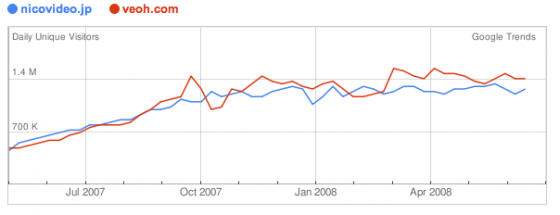![]() Can a geek-driven video portal beat YouTube in Japan?
Can a geek-driven video portal beat YouTube in Japan?
One of the most spectacular success stories in the Asian web market is currently being written by Nico Nico Douga (“smiling videos”), a video sharing platform from Japan. As one of the country’s most visited sites, it still trails the Japanese version of YouTube. But Nico Nico is catching up very quickly.
The site, which is available only in Japanese and requires registration to view videos, managed to attract nearly 6 million registered users since its launch in January 2007. The number of users of the mobile version exceeded the 1.2 million mark in March this year. Nico Nico racks up around two billion page views per month. The site is estimated to carry one twelfth of Internet traffic in Japan. Google Trends for Websites doesn’t break out YouTube properties, but it does show Nico Nico to be attracting about as many visitors as Veoh does worldwide (about 1.4 million on a daily basis, see chart below).
Unique characteristics
Nico Nico’s most distinctive feature is that members communicate via short texts inserted on top of the video feeds. Entries are time-synched and flow over the frame from right to left. Using different colors, other users can add comments later in the same way. Some videos are virtually covered with thousands of lines of text, which can be filtered or turned off.
This feature sounds totally absurd but is the main reason why users spend twice as much time on Nico Nico as they do on Youtube. Until today, over 1.2 billion comments were added to the 1.1 million videos on the site, up from 600 million in November 2007. The content mainly consists of Nico Nico-“exclusive” material such as video-game sequences, bizarre comedy clips, anime and user-made footage.
Embedding Nico Nico content is restricted, but this Youtube video serves as a good example of what is typically being contributed:
An additional advantage Nico Nico has over the American archetype must be seen in its strong Japanese identity. The site is deeply rooted in this country’s geek culture, which is reflected in the Manga-inspired design and wild layout.
Moreover, there is no restriction regarding the length of videos, which are usually higher in picture quality. And, in contrast to Youtube, Nico Nico welcomes uploading of erotic content in its so-called R-18 section.
Three-pillar business model
Niwango, the company operating Nico Nico, is one of 15 subsidiaries of Dwango, a media group listed on the Tokyo Stock Exchange.
Nico Nico generates revenue in three different ways. There are currently 200,000 Premium members (up from 90,000 in November 2007) who pay $5 per month for easier access to the site and additional functions. Niwango also sells ad space, accounting for around $300,000 monthly. Sales from affiliate links generate approximately $820,000 per month (official figures for February 2008). That adds up to $2.1 million a month, or a $25 million annualized revenue run-rate.
But maturing as a company, Niwango faces some serious hurdles looking ahead. Nico Nico burns close to $1 million monthly due to high server expenses, with overall costs rising faster than revenues.
The company is currently trying to get in the black. In May, it partnered up with Yahoo! Shopping to expand its affiliate business. Nico Nico videos also prominently appear in the Yahoo! Japan search index now. This is a promising move: Yahoo! Japan is this country’s biggest web company.
However, the mobile version of Nico Nico is still completely free of ads. Niwango also has to deal with a number of copyright infringement problems.
In terms of scaling, the biggest challenge will be to find ways to open Nico Nico for the Japanese mainstream user. Most of the current members are male Otaku, anime and video game freaks with a high level of tech literacy.
International versions could spur growth as well: The site’s popularity already spawned a Chinese copycat. An official version for users living in Taiwan was launched as early as October 2007.
While the concept might not translate to the U.S., the ability to comment directly on videos with text is a feature that could catch on elsewhere.
